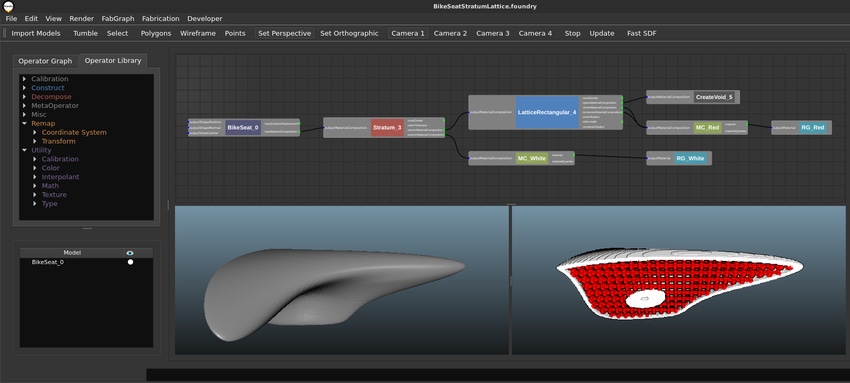MIT's Foundry Interface Is the Photoshop of 3D Printing
A team of researchers at MIT have developed a system for designing multi-material objects that it hopes will do for 3D printing what Photoshop did for graphic design.
January 2, 2017

The technology to 3D print with multiple materials is still an expensive prospect. Last year, researchers at MIT's Computer Science and Artificial Intelligence Laboratory (CSAIL) introduced MultiFab, a printer that can create multi-material objects in a single print run. At the time of its introduction, MultiFab was lauded as a reasonable cost alternative to existing multi-material printers with $250,000 price tags.
|
The Foundry interface is designed to be more user-friendly than previous multi-material printing solutions. (Image source: MIT Computer Science and Artificial Intelligence Laboratory (CSAIL). |
Costs aside, another problem has plagued multi-material 3D printing – a lack of solutions with interfaces user-friendly enough for non-programmers to cope with. MIT's CSAIL has addressed this problem, as well, with the introduction of Foundry, a system for custom designing a variety of 3D-printed objects with multiple materials that doesn’t require a PhD in programming to understand.
Existing commercial multi-material 3D printers are largely used for rapid prototyping, so the bundled software simply allows discrete material assignments to each part in an assembly, since the final product will still be manufactured using a traditional manufacturing process.
Kiril Vidimče, a MIT PhD student who is first author on the paper that presented the new interface, told Design News that Foundry differs from previous multi-material systems because it targets true multi-material additive manufacturing processes where the final part is designed and manufactured using 3D printing. Vidimče refers to Foundry as “Photoshop for 3D materials.”
“To truly leverage the capabilities of such a fabrication platform, one needs to allow the user to take advantage of the capability to spatially vary material assignments at the target fabrication resolution,” he said. “Existing inkjet-based multi-material printers can print with a resolution of up to 1600 DPI (~16 microns). There are currently no tools that would allow a user to design metamaterials or spatially-varying materials at such high resolution.”
Then there are the processes that would have been impossible and not simply complex with previous multi-material printing platforms.
“Even though there are some generative tools out there (e.g., ones that produce lattice geometries), there are no design tools that output material compositions,” said Vidimče. “As such, if you wanted to produce a part that, for example, varies in elasticity along its length, there are no tools to design such behavior.”
Foundry’s very high resolution could even open up new additive manufacturing capabilities, such as creating parts with varying material properties. For instance, when designing electronics packaging that needs to be shielded and mounted in a rugged environment, a designer could create it to be rigid where the mounting occurs, and then slowly become more elastic near the electronics for the purpose of shock absorption. Similarly, a dental appliance could be created that varies from strong and rigid where it’s mimicking the hardness of teeth to a soft and compliant material that interacts with the gums.
“In general, spatially-varying materials allow a paradigm shift in product design,” Vidimče told Design News. “Instead of selecting a particular material from a catalog based on its known mechanical or thermal properties, a designer can precisely specify the required properties in a continuous space. The materials actually used during the printing process can serve as something akin to basis vectors that span a particular continuum of material properties that can be described using these constituent materials. By using different topological arrangements of the basis materials, the product designer can freely interpolate within this continuum and match the precise functional requirements of the final part,” he said.
While MIT uses Foundry with its MultiFab printer, Vidimče said the platform can be used with any commercially available multi-material printer. It is, however, much more useful for a platform that is capable of producing end-use parts. Otherwise, the design would not be manufacturable with a traditional manufacturing process.
“To truly take advantage of these kind of software capabilities, we need access to scalable additive manufacturing platforms that use functional materials and can produce end-use parts in volume,” said Vidimče. “At that point, I imagine software like ours to be used both as part of the design process (in a rapid prototyping workflow mode) and the final fabrication process (for volume production).”
Pacific Design & Manufacturing 2017 | Registration is open! Pacific Design & Manufacturing connects you with over 20,000 engineers and executives, as well as hundreds of leading suppliers, across the advanced design and manufacturing spectrum who understand the value in working together on the industry’s cutting edge. Register Today! |
Currently, users must design the geometry of their parts using traditional CAD software and then import the geometry in Foundry to design the final material composition, but the MIT team is exploring the possibility of integrating Foundry into existing CAD programs where the material design is seamlessly interwoven with the geometry design.
Going forward, the team at MIT would like to enable true preview of the behavior of the designed part. However, the computational complexity of doing this with spatially-varying materials requires a radically different approach to physics simulation.
“Making a simulator be efficient and work seamlessly in a design tool such as Foundry is a significant challenge,” said Vidimče.
Tracey Schelmetic graduated from Fairfield University in Fairfield, Conn. and began her long career as a technology and science writer and editor at Appleton & Lange, the now-defunct medical publishing arm of Simon & Schuster. Later, as the editorial director of telecom trade journal Customer Interaction Solutions (today Customer magazine) she became a well-recognized voice in the contact center industry. Today, she is a freelance writer specializing in manufacturing and technology, telecommunications, and enterprise software.
About the Author(s)
You May Also Like





